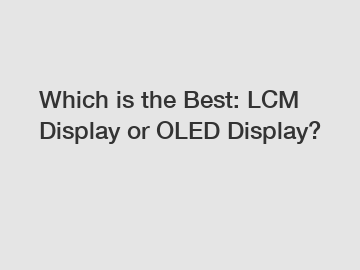Which is the Best: LCM Display or OLED Display?
Which is the Best: LCM Display or OLED Display?
When it comes to choosing between LCM (Liquid Crystal Module) Display and OLED (Organic Light-Emitting Diode) Display, it is essential to consider various factors. Both display technologies have their own merits and limitations, but ultimately, the decision depends on the specific requirements of the application. In this article, we will explore the differences between LCM and OLED displays, their advantages, and the impact they have on different industries.
LCM displays, also known as LCD (Liquid Crystal Display), have been the standard choice for many years due to their widespread availability and cost-effectiveness. These displays rely on a backlight source to illuminate the liquid crystals, producing the desired visual output. LCM displays are highly versatile and can be found in a wide range of devices, such as televisions, computer monitors, and smartphones.

On the other hand, OLED displays have gained popularity in recent years due to their superior image quality and energy efficiency. Unlike LCM displays, OLED displays do not require a backlight source as each individual pixel emits its own light. This results in deeper blacks, higher contrast ratios, and improved color accuracy. Additionally, OLED displays are thinner and more flexible, allowing for curved or foldable form factors.
One of the key factors in determining the best display technology is the intended use case. LCM displays are well-suited for applications where cost-effectiveness and widespread availability are essential. They offer a good balance between performance and price, making them the preferred choice for budget-friendly devices. Additionally, LCM displays have mature manufacturing processes, ensuring consistent quality and reliability.
On the other hand, OLED displays excel in delivering superior image quality and energy efficiency, making them ideal for applications where visual excellence is paramount. The deep blacks, vibrant colors, and wide viewing angles offered by OLED displays enhance the overall user experience. OLED displays are particularly suitable for high-end smartphones, televisions, and virtual reality devices, where image quality plays a crucial role in consumer satisfaction.
The impact of choosing between LCM and OLED displays goes beyond individual devices. The choice of display technology can have significant implications for various industries. For example, in the smartphone industry, OLED displays have revolutionized the user experience by providing vivid and immersive visuals. Similarly, in the automotive sector, OLED displays are being adopted to enhance the driver's interface, ensuring better visibility and safety.
In conclusion, the best display technology, whether it is LCM or OLED, depends on the specific requirements of the application. LCM displays offer cost-effectiveness and widespread availability, making them suitable for budget-friendly devices. On the other hand, OLED displays provide superior image quality and energy efficiency, making them ideal for applications where visual excellence is paramount. As technology continues to advance, it is likely that both LCM and OLED displays will coexist, each serving different needs in various industries.
If you want to learn more, please visit our website lcd backlight panel, gas meter screens, Dianguang Electronics.
160
0
0


Comments
All Comments (0)